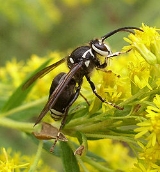
Vespoidea
Encyclopedia
Vespoidea is a superfamily of order
Hymenoptera
of class
Insecta, although older taxonomic
schemes may vary in this categorization, particularly in their recognition of a now-obsolete superfamily Scolioidea. The members of this group are wasps and ants.
Phylogenetic relationships of Vespoid families based on Brothers (1999)
Newer research based on four nuclear genes (elongation factor-1α F2 copy, long-wavelength rhodopsin, wingless and the D2–D3 regions of 28S ribosomal RNA (2700 bp in total)) suggest that the higher level relationships need to be changed with Rhopalosomatidae as a sister group of the Vespidae and the clade Rhopalosomatidae + Vespidae as sister to all other vespoids/apoids. Additionally, superfamily Apoidea is found to be within the Vespoidea, suggesting the dismantling of the superfamily into many smaller superfamilies. Families Mutillidae, Tiphiidae, and Bradynobaenidae are also noted to be paraphyletic.
Order (biology)
In scientific classification used in biology, the order is# a taxonomic rank used in the classification of organisms. Other well-known ranks are life, domain, kingdom, phylum, class, family, genus, and species, with order fitting in between class and family...
Hymenoptera
Hymenoptera
Hymenoptera is one of the largest orders of insects, comprising the sawflies, wasps, bees and ants. There are over 130,000 recognized species, with many more remaining to be described. The name refers to the heavy wings of the insects, and is derived from the Ancient Greek ὑμήν : membrane and...
of class
Class (biology)
In biological classification, class is* a taxonomic rank. Other well-known ranks are life, domain, kingdom, phylum, order, family, genus, and species, with class fitting between phylum and order...
Insecta, although older taxonomic
Taxonomy
Taxonomy is the science of identifying and naming species, and arranging them into a classification. The field of taxonomy, sometimes referred to as "biological taxonomy", revolves around the description and use of taxonomic units, known as taxa...
schemes may vary in this categorization, particularly in their recognition of a now-obsolete superfamily Scolioidea. The members of this group are wasps and ants.
Vespoid Families
- BradynobaenidaeBradynobaenidaeBradynobaenidae is a family of wasps similar to the Mutillidae. These species are often found in arid regions.- Genera found in Europe :* Apterogyna Latreille, 1809* Gynecaptera Skorikov, 1935- Other genera :* Bradynobaenus Spinola, 1851...
- Formicidae - Ants
- MutillidaeMutillidaeMutillidae are a family of more than 3,000 species of wasp whose wingless females resemble ants. Their common name velvet ant refers to their dense pile of hair which most often is bright scarlet or orange but may also be black, white, silver, or gold. Their bright colours serve as aposematic signals...
- Velvet Ants - Pompilidae - Spider WaspSpider waspWasps in the family Pompilidae are commonly called spider wasps . The family is cosmopolitan, with some 5,000 species in 6 subfamilies...
s - RhopalosomatidaeRhopalosomatidaeRhopalosomatidae is a family of Hymenoptera. It contains about 68 extant species in four genera that are found worldwide. Three fossil genera are known....
- Rhopalosomatid Wasps - SapygidaeSapygidaeThe Sapygidae are a family of solitary aculeate wasps. There does not seem to be a common English name, but Club-horned wasps seems as good a name as any, though various other groups of wasps also have clubbed or thickened antennae...
- Sapygid Wasps - ScoliidaeScoliidaeScoliidae, the scoliid wasps, is a small family represented by 6 genera and about 20 species in North America, but they occur worldwide, with a total of around 300 species. They tend to be black, often marked with yellow or orange, and their wing tips are distinctively corrugated...
- Scoliid Wasps - SierolomorphidaeSierolomorphidaeThe Sierolomorphidae are a family of about 10 known species of wasps found in Tropical America and Asia. They are rare and very little is known of their biology....
- Sierolomorphid Wasps - TiphiidaeTiphiidaeTiphiidae is a family of large solitary wasps whose larvae are almost universally parasitoids of various beetle larvae, especially those in the superfamily Scarabaeoidea....
- Tiphiid wasps - Vespidae - Paper WaspPaper waspPaper wasps are -long wasps that gather fibers from dead wood and plant stems, which they mix with saliva, and use to construct water-resistant nests made of gray or brown papery material...
s, HornetHornetHornets are the largest eusocial wasps; some species can reach up to in length. The true hornets make up the genus Vespa and are distinguished from other vespines by the width of the vertex , which is proportionally larger in Vespa and by the anteriorly rounded gasters .- Life cycle :In...
s, Potter WaspsPotter waspPotter wasps are a cosmopolitan wasp group presently treated as a subfamily of Vespidae, but sometimes recognized in the past as a separate family, Eumenidae.-Recognition:...
, Yellow Jackets, and relatives
Newer research based on four nuclear genes (elongation factor-1α F2 copy, long-wavelength rhodopsin, wingless and the D2–D3 regions of 28S ribosomal RNA (2700 bp in total)) suggest that the higher level relationships need to be changed with Rhopalosomatidae as a sister group of the Vespidae and the clade Rhopalosomatidae + Vespidae as sister to all other vespoids/apoids. Additionally, superfamily Apoidea is found to be within the Vespoidea, suggesting the dismantling of the superfamily into many smaller superfamilies. Families Mutillidae, Tiphiidae, and Bradynobaenidae are also noted to be paraphyletic.

